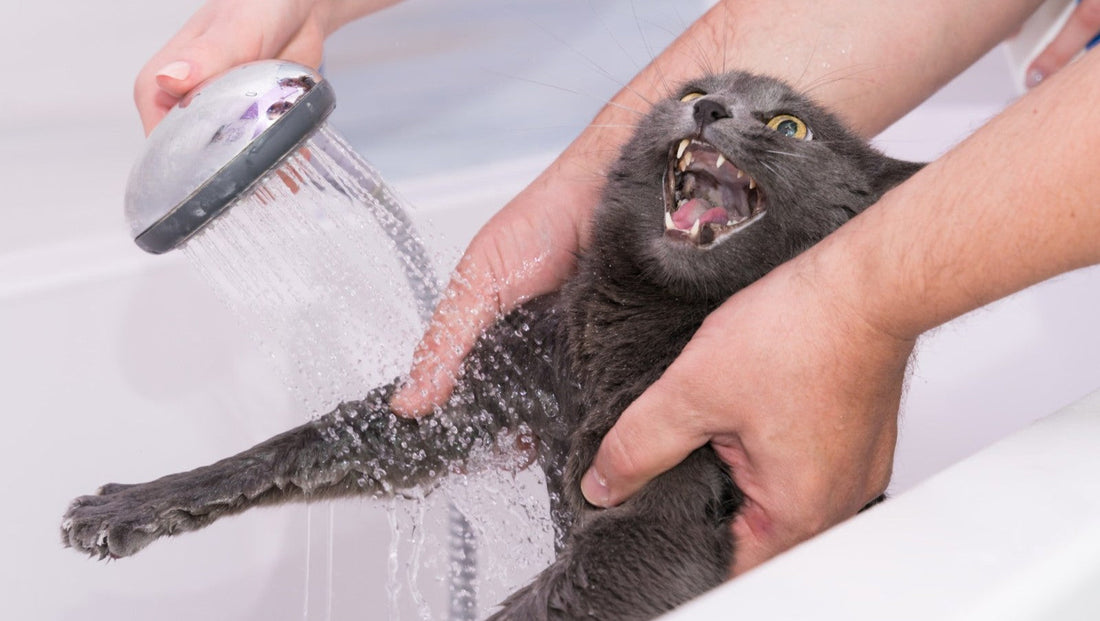
How Often Should I Bathe My Cat?
Share
In the hot and humid climate of the Philippines, it’s common for Filipinos to take multiple showers a day.
But what about our cats, do they need to bathe as often, if at all?
Do Cats Really Need Baths?

Fun fact: cats spend up to half their day grooming themselves, using their rough tongues to remove dirt, loose fur, and odors. This habit actually makes baths unnecessary (most of the time) for your pusa.
“Bathing them 1-2 times per year is sufficient,” said UK-based veterinarian Amir Anwary, adding that over-bathing cats could strip essential oils from their skin.
In addition, the experience can even traumatize poor Muning since, you know, cats cartoonishly despise water.
“The act of bathing cats can cause behavioral trauma, which may affect the human-animal bond if this is not something the cat is used to,” said Dr. Alison Diesel, a clinical associate professor at the Texas A&M College of Veterinary Medicine & Biomedical Sciences.
Dr. Diesel added: “For an adult cat that has not had a bath previously, the experience can be quite traumatic. They may lash out, bite, and scratch; this obviously introduces safety concerns for the owners.”
When Should You Bathe a Cat?

So, the general rule of bathing cats is that you don’t have to. However, here are some exceptions wherein you really should bathe your pet:
Your cat has fleas or ticks
If your cat has fleas or ticks, a medicated bath might help reduce the infestation. Always check with your vet before bathing, as some shampoos can be too harsh or even toxic.
In most cases, your vet will recommend flea treatments like spot-on meds or oral tablets alongside any bathing.
Your cat has long fur that gets matted or dirty easily
Long-haired breeds like Persians or Ragdolls are more prone to tangles, mats, and dirt buildup. If regular brushing isn’t enough to keep their coat clean, an occasional bath can help loosen debris and prevent skin problems under the mats.
Your cat rolled in something smelly or sticky
And, if Mingming gets into something sticky, greasy, or potentially toxic—like oil, paint, or garbage—a bath is definitely necessary to remove it.
“In short, anything that could be harmful to their fur or skin should be washed off right,” explained Hunter’s Animal Hospital.
Your cat has a skin condition
There are certain skin conditions—like seborrhea, fungal infections, or ringworm—that can benefit from medicated baths prescribed by your vet. These shampoos are formulated to soothe irritation, reduce flaking, or treat infections.
Never self-diagnose or use over-the-counter shampoos without guidance, as the wrong product could make the condition worse.
Your cat is old, disabled, or overweight
Felines who are elderly, overweight, or have mobility issues may struggle to groom themselves properly. You might notice greasy fur, dandruff, or a dirty rear end.
“This means that you may need to step in and bathe them in order to help keep them clean,” said Windermere Veterinary Services.
How Often Should You Bathe Your Cat?

As mentioned, a cat bath about once or twice a year should suffice. But if your kuting has one or more of the conditions discussed above, then a quick paligo is needed.
Here’s a general guideline:
|
Cat Type |
Bath Frequency |
|
Short-haired indoor cat |
Rarely or only when dirty |
|
Long-haired indoor cat |
Every 4–6 weeks |
|
Outdoor cat |
Every 4–6 weeks or as needed |
|
Cats with medical conditions |
As recommended by your vet |
Tip: Although cats don’t need regular bathing, they do require regular brushing. For long-haired cats, brush them daily. For short-haired ones, brush them once a week.
Unless You Own a Sphynx

The one real exception to the points we discussed above is the Sphynx. For this cat breed, bathing regularly is encouraged.
“For cat breeds like Sphynx in which there are known genetic conditions that cause them to produce and secrete an excess amount of skin oil, routine bathing can help decrease the extra debris and the chance of secondary skin infections,” said Dr. Diesel. “In general, though, this doesn’t need to be more than once every one to two weeks.”
To make bath time more enjoyable, she advises Sphynx owners to train their pet while young. Dr. Diesel elaborated: “Getting a Sphynx kitten used to baths early in life is imperative for managing this breed.”
Conclusion

Bathing a cat is rarely a priority. Yet there are moments when even the most fastidious pusa might need a little help, whether due to illness, sticky situations, or simply the challenges of aging.
The key to a clean, healthy cat isn’t frequent baths but consistent care: gentle brushing, quality nutrition, and regular vet check-ups. When in doubt, trust your cat’s instincts (and your vet’s advice). Because at the end of the day, a content cat isn’t one that’s scrubbed spotless, but one that’s cared for with understanding and love.
